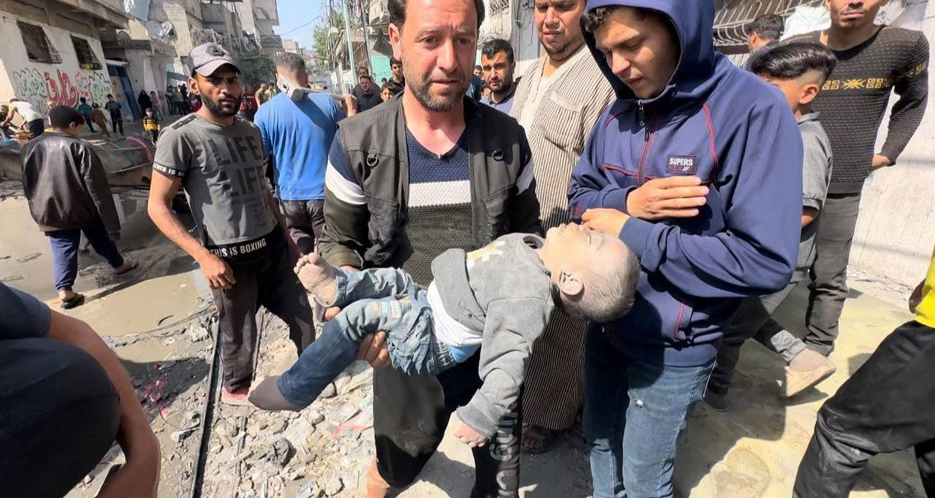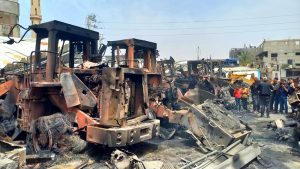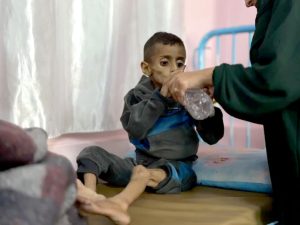
AT DAWN on 26th April, a single Israeli airstrike obliterated an entire Palestinian family in central Gaza’s al-Sabra neighbourhood.
The al-Khour family, spanning three generations, were killed instantly when their five-storey home was reduced to rubble.
Among the twenty-two victims were twelve children, none of whom survived.
The eldest family member, Talal al-Khour, was killed alongside his wives, daughters, sons and grandchildren.
Their remains were scattered amid the debris, mangled and torn apart by the force of the explosion.
‘The strike hit while we were sleeping. It felt like the ground itself had exploded,’ said 37-year-old neighbour Mohammad Al-Ajla, who rushed outside moments after the blast.
‘When the dust cleared, we saw that the building was just gone.
‘People immediately tried to dig with their hands to reach anyone who might still be alive.’
Al-Ajla, one of many who joined the desperate rescue effort, recalled the devastation in graphic detail: ‘There were children without heads. Limbs scattered. The horror is indescribable.’
Civil Defence workers, with the aid of local residents, managed to recover fifteen of the bodies, later buried together in a single grave.
The rest remain buried beneath the wreckage.
Mahmoud Bassal, spokesperson for the Civil Defence, described the crippling impact of Israel’s blockade on rescue efforts.
‘We had no tools. Israel has blocked rescue equipment from entering and destroyed the few machines we had. We were forced to dig with our bare hands,’ he said.
‘We could hear people screaming underneath the rubble.
‘Then the cries faded. We don’t know if they died waiting or were still alive but unreachable.’
This mass killing is only one instance in an unrelenting campaign of genocide being perpetrated by Israel across Gaza since 18 March.
That date marked the intensification of Israel’s aerial and ground assault, which has since turned the entire strip into a wasteland of blood and rubble.
Each day brings new atrocities: Airstrikes on homes, displacement camps, cafes, hospitals, and sites designated as ‘humanitarian zones’.
The bombardments are so frequent and widespread that even documenting them fully is impossible.
On a single day last week, Israel bombed three residential buildings in the Nuseirat refugee camp.
One strike killed six members of a family, three of whom were siblings and all children. A nearby house saw eight more lives extinguished.
In Jabaliya, Israeli artillery fire killed at least three more, including two young girls.
Elsewhere, a fisherman was gunned down while pulling in his boat. In Khan Younis, a drone strike on a tent killed six people overnight, including children.
These incidents represent just a fraction of one day’s destruction.

Over a 48-hour period last week, Israeli forces also deliberately destroyed more than thirty bulldozers and heavy-duty machines, many of which had been donated to aid post-strike rescue and infrastructure repair during the ceasefire.
The United Nations Office for the Coordination of Humanitarian Affairs (OCHA) confirmed that these machines were being used to clear rubble and save lives before being systematically targeted.
From Rafah in the south to Beit Hanoun in the north, Gaza has become a tableau of horror. Children’s bodies lie mangled on rooftops or beside wrecked bicycles.
Cafes are strewn with corpses, some still seated, coffee cups beside them. White body bags are lined up in rows.
Suicide drones strike tents filled with sleeping families. The air is filled with the screams of parents mourning their slaughtered children and the wounded crying out for help that never comes.
‘The massacres do not stop. We are being slaughtered from vein to vein,’ said journalist Anas al-Sharif, describing the bloodshed in a post on social media.
The death toll in the past six weeks alone has surpassed 2,300 Palestinians – an average of more than fifty people killed every day. Of those, at least 740 were children.
Zaher Al-Wahidi, Director of the Information Unit at Gaza’s Ministry of Health, confirmed the figures, adding that over 2,180 families have been entirely exterminated, with every member killed.
An additional 5,070 families now consist of just one surviving person.
These killings occur in parallel with Israel’s policy of forced starvation.
Since 2nd March, Israel has imposed a complete blockade on Gaza, denying entry of food, fuel, medicine and all humanitarian supplies.
It is the longest such siege since the war began.
The Government Media Office reports that over 65,000 children have required hospital treatment for acute malnutrition since the blockade’s tightening.
Israeli officials have admitted that this policy of collective punishment is deliberate.
Israeli defence minister Israel Katz bluntly stated: ‘No humanitarian aid is about to enter Gaza,’ and referred to the denial of aid as a ‘main pressure lever’ against Hamas.
The result has been a humanitarian catastrophe beyond description.
The United Nations recently issued a stark warning that Gaza may be experiencing the worst humanitarian crisis since hostilities resumed in October 2023.
The World Food Programme has declared it has run out of supplies, noting that the population is now at ‘breaking point’.
With food prices soaring by 1,400 per cent, and all fuel and flour reserves exhausted, Gaza’s bakeries have shut down.
The little flour that remains is often infested with insects.
Many families survive on just one piece of bread per person per day, some made by mixing crushed pasta with whatever flour they can find.
In the absence of cooking gas or firewood, people are burning plastic waste to prepare the small amounts of food they have.
Families are foraging for wild plants and even eating sea turtles washed ashore to survive.

In March, the UN documented 3,700 cases of acute child malnutrition – a figure that rose by 80 per cent in April.
So far, fifty-three children have died of starvation.
Twelve leading aid agencies issued a joint statement last week, warning that famine is no longer a distant threat but is rapidly unfolding in nearly every area of Gaza.
They described the situation as ‘one of the worst humanitarian failures of our generation’.
Amid this suffering, Israel continues to target Gaza’s health infrastructure.
Recent strikes have hit al-Ahli Hospital and Al Durrah Paediatric Hospital in Gaza City, the Nasser Hospital in Khan Younis, and the Kuwaiti Field Hospital in Mawasi.
At least fifteen medical workers and first responders have been killed.
Hospitals that remain standing are barely operational, crippled by shortages of medicine, equipment and staff.
Israel’s military strategy also includes shrinking the already devastated territory available to Palestinians.
Over 70 per cent of Gaza has been marked as a ‘no-go’ area or subjected to forced evacuation orders.
In the past six weeks alone, an estimated 420,000 people have been forcibly displaced once again.
With nowhere left to flee, families are trapped in ever-smaller areas of the strip under constant threat of bombardment.
‘This is deprivation by design,’ said Jonathan Whittall, Acting Head of OCHA’s Gaza office.
‘Land is being annexed from all directions. Gaza is being starved, bombed, and strangled. This looks like the deliberate dismantling of Palestinian life.’
As the genocide continues, diplomatic negotiations have all but collapsed.
Israel has reneged on key components of a ceasefire agreement first brokered in January, now insisting that Hamas must completely surrender, disarm and send its leadership into exile as a condition for halting the assault.
In the meantime, the people of Gaza are left to endure relentless war crimes with no respite, no aid, and no international accountability.
• See editorial